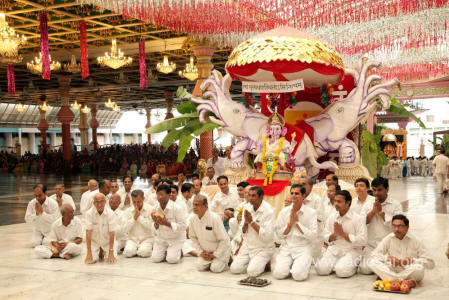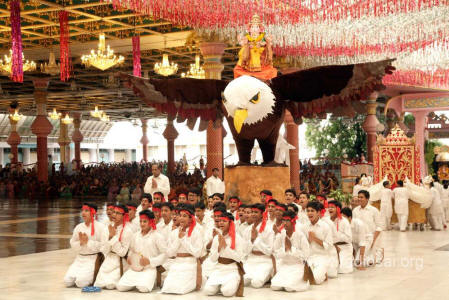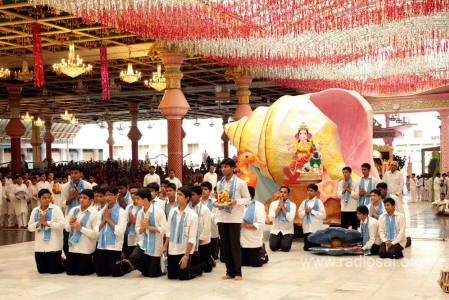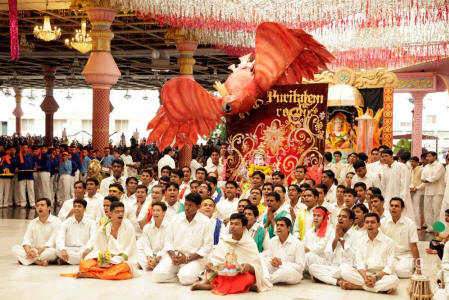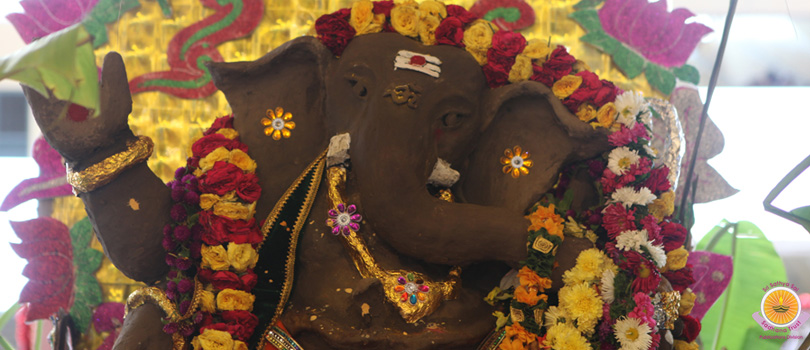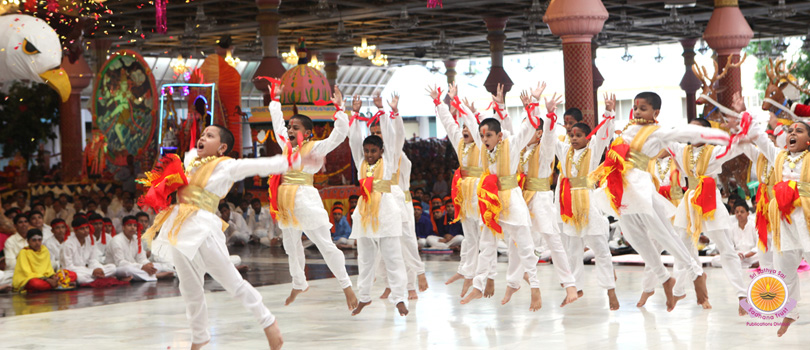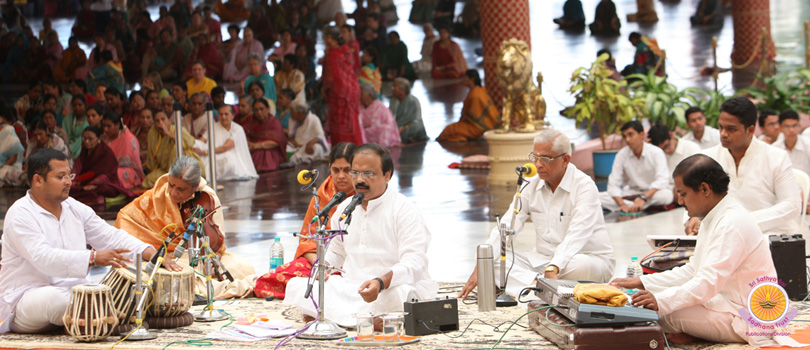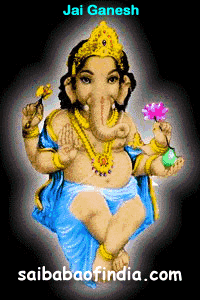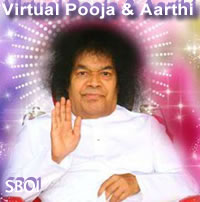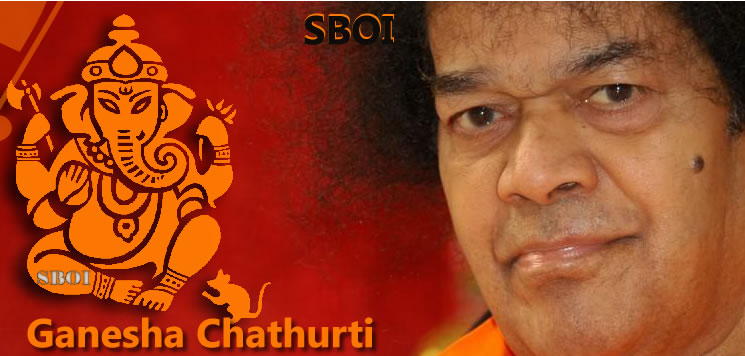 |
|||||||||||
|
2014 Ganesh Chaturthi Celebrations
at Prasanthi Nilayam |
|||||||||||
| Text & photo source - copyrights: Sri Sathya Sai Sadhana Trust - sssbpt.org - Radiosai.org Prasanthi Diary - theprasanthireporter.org | Web layout - Photo graphic design : saibabaofindia.com "SBOI" | - We gratefully acknowledge the publishers Sri Sathya Sai Sadhana Trust & Sri Sathya Sai Media Foundation | |||||||||||
|
Prasanthi News Mahasamadhi updates, Videos & Photos
Photos &
Video Webcast of the Ganesh Idols Immersion Ceremony at Prasanthi Nilayam - 31
Aug 2014 |
|||||||||||
|
29 August 2014: Celebrating Ganesh Chaturthi, students from
SSSIHL offered a string of hymns propitiating Lord Ganesha yesterday, 29 August
morning, at the Sanctum Sanctorum in Prasanthi Nilayam.
Singing special hymns invoking the Lord, Who is hailed as ‘Prathama Vandana’, the students regaled Bhagawan for over half-an-hour. They began with a Ganesha Strotram and continued with Ganashtakam…, Ganesha Pancharatna Strotram… Mudakaratha Modakam…, Siddhi Vinayaka Hey Gananatha…, Ganapathi Deva Gowri Nandana…, Sree Ganesha Shivuni Kumara…etc. Bhajans continued and ended with Mangala Arathi at 0940 hrs.
A speech by Sri Bishu Prusti, alumnus and currently with Radio Sai on the topic “Lessons From The Primordial Principle” followed by Divine discourse, aired in public address system, featured in the evening session. The session ended with Bhajans and Mangala Arathi. II Samastha Lokah Sukhino Bhavantu II
|
|||||||||||
|
Watch the Recorded Video Webcast of the Ganesh Idols
Immersion Ceremony at Prasanthi Nilayam - 31 Aug 2014
1 Sept 2014: Quite distinct from the world outside, clearly
distinctive, Prasanthi often brings a pristine touch of character, discipline,
dedication and devotion in all that she presents to the world outside. Marking
the grant culmination of Ganesh Chaturthi celebrations Prasanthi bid farewell to
Ganeshas ‘Who’ were taken out for immersion in a regal procession held yesterday
evening here in Prasanthi Nilayam. As per the set tradition in Prasanthi,
Ganeshas go for immersion on the third day of the festivity, Ganesh Chaturthi.
This evening’s function was marked with religious exuberance with en masse
participation of students and staff. |
|||||||||||
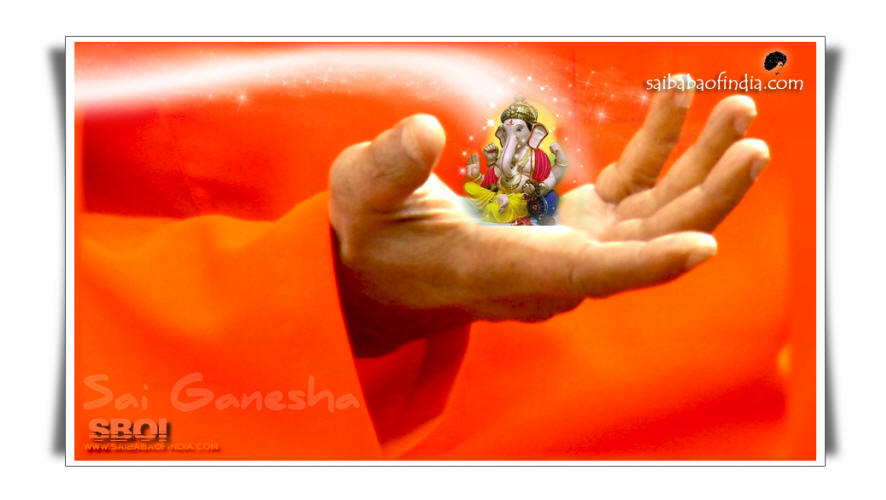 |
|||||||||||
| Ganesh Chaturthi - in 2014 is on
Friday, the 29th of August.
Ganesh Chaturthi/Vinayaka Chaturthi in India - Puttaparthi - Prasanthi Nilayam |
|||||||||||
|
Vinayaka is the Lord of all learning (vidya). Does learning mean bookish scholarship? No. Everything pertaining to the cosmos is included in the term learning (vidya). Walking, talking, laughing, sitting, eating, strolling, thinking --every kind of activity is related to learning. Vinayaka is the master of every kind of learning. Today, learning is identified with acquisition of information. But apart from knowledge of the physical world, we have many other kinds of knowledge, relating to chemistry, the fine arts and other skills. Vinayaka is the master of every kind of knowledge. Learning is related to the intellect (buddhi). It is not mere scholarship. Familiarity with books is not knowledge. One's entire life is a continuous process of learning. Any process of inquiry is related to learning. But basically our inquiry should be concerned with finding out what is transient and what is permanent. This is true knowledge. Hence, today, students worship Vinayaka with zeal. Vinayaka is not the one who merely comes to the aid of those who read their books. He helps everyone at every step in life's journey.
Sanathana Sarathi, October 1995
From: A Compendium of the Teachings of Sathya Sai Baba, pp. 115 Who is Vinayaka? In the verse (sloka)
beginning with the words Suklaambara- dharam Vishnum,
only the form of the deity is described. However, the Vinayaka-principle has only one meaning, which is relevant to everyone regardless of whether he is a believer or a non-believer. Vinayaka means that he is totally master of himself. He has no master above him. He does not depend on anyone. He is also called Ganapathi. This term means he is the lord of the ganas --a class of divine entities. This term also means that he is the master of the intellect and discriminating power in man. He possesses great intelligence and knowledge. Such knowledge issues from a pure and sacred mind. This knowledge leads to wisdom (vijnaana). Because he is the master of intelligence (buddhi) and wisdom or realisation ( siddhi), he is described as the Lord of Buddhi and Siddhi. Buddhi and Siddhi are referred to as the consorts of Vinayka. The mouse is the vehicle of Vinayaka. What is the inner significance of the mouse? The mouse is considered as the embodiment of the sense of smell. The mouse is a symbol of the attachment to worldly tendencies (vasanas). It is well known that if you want to catch a mouse, you place a strong-smelling edible inside the mouse-trap. The mouse also symbolises the darkness of night. The mouse can see well in the dark. As Vinayaka's vehicle, the mouse signifies an object that leads man from darkness to light. Thus, the Vinayaka-principle means that which removes all the bad qualities, bad practices, and bad thoughts in men and inculcates good qualities, good conduct and good thoughts. Another name for Vinayaka is Vighneswara. Easwara is one who is endowed with every conceivable form of wealth --riches, knowledge, health, bliss, beauty, etc. Vighneswara is the promoter of all these forms of wealth and removes all obstacles to their enjoyment. He confers all these forms of wealth on those who worship him. Vinayaka is described as "the first deity who should be worshipped (prathama vandana)". Since everyone in the world desires wealth and prosperity, everyone offers the first place for worship to Vighneswara.
Divine Discourse: Ganesh Chaturthi, 12 September 1991
What is the meaning of the name Ganapathi? Where are the ganas? What is their form? When you investigate this, you find that the five organs of perception and the five organs of action (jnaanendriyas and karmendriyas) are the ganas. The mind is the master over these ten organs. The intellect (buddhi) is the discriminating faculty above the mind. The ten senses, the mind, and the intellect together constitute the ganas.
When Ganapathi is described as "Parvathee thanaya", who is this Parvathee? Parvathee signifies Prithvi, Mother Earth. Everyone is a child of Mother Earth. The meaning of "son of Parvathee (Parvatheethanaya)" is that Ganapathi, who is the Lord of the Ganas, is the son of Parvathee, who symbolizes the divine energy (sakthi). The adoration of Parvathieeand Ganapathi is not of recent origin. Ganapathi is lauded at several places in the Rig Veda. This clearly shows that Ganapathi is as ancient as the Vedas. In several places, Ganapathi is mentioned both in the Vedas and the Upanishaths. Many prayers are addressed to Ganapathi in the Narayanopanishath. There are also prayers to him in the Thaithiriya Upanishath. The Ganapathi Gayathri Mantra also figures in the Upanishath. Ganapathi is called Vinayaka because there is no master above him. He is all powerful and independent. Without recognizing the esoteric significance of the Vinayaka Principle, people look only at the external form and offer worship in mundane terms. What is the inner significance of worshipping the elephant-faced deity? The elephant is a symbol of might and magnitude. The elephant's foot is larger than that of any other animal. The elephant can make its way through the densest jungle. In this way, it signifies the quality of a leader who shows the way for others. The elephant is also known for its fidelity and gratitude. In any circumstance, it will not forget its master. Even in its last moments, if it hears the voice of its master, it will open its eyes and look for him. It will sacrifice its life for its master. These are the lessons man should learn from the elephant. Intelligence without gratitude is valueless. Every man should be grateful to those who have helped him.
Divine Discourse: Ganesh Chaturthi, 7 Sept 1997
|
|||||||||||
| Indian culture believes in the concept of
pantheism – God can be identified with all the forces of nature and with all
natural things. That is why our ancients worshipped trees. People worship snakes
and elephants and our Indian mythology speaks volumes testifying this fact. Among the Indian Gods and Goddesses, Vinayaka is given the prime place. Vinayaka has an elephant head and the body of a human. How Vinayaka assumed such a form is explained in the scriptures. Please read on for details … To view Ganesha animation click on the image
Who is Vinayaka? The essential purpose of the Vinayaka Chaturthi festival is to teach a person to avoid the company of bad people and cultivate the company of the good. What does the term Ganapathi signify? ‘Ga’ means Buddhi or intellect, ‘Na’ means Jnana (Wisdom). ‘Ganapathi’ means one who is the Lord of the intellect and of wisdom. He is also the Lord of all Ganas (spiritual entities). Ganas also symbolise the senses. Ganapathi is thus the Lord of the senses. Story of Ganesha’s origin
There is another legend explaining Ganesha’s origin: Once upon a time there was an Asura (demon) named Gajasura. He performed a penance. Easwara, pleased with his penance, offered him as a boon whatever he desired. Easwara is a deity who is easily propitiated. Hence he is known as Bhola-Sankara. When he is pleased with a devotee, He gives the devotee whatever he asks. Sometimes He gets into a ‘difficult’ situation, as in the case of Bhasmasura who was granted by Siva the boon to turn into ashes anyone on whose head he placed his palm. Immediately after getting the boon he wanted to test his power by trying to place his hand on Siva’s head itself! What was the boon Siva gave to Gajasura? The demon desired that fire should go forth from him continuously so that no one dared to approach him. Siva granted him the boon. Gajasura continued to do penance and Siva would appear before him off and on. Once Siva asked him what he wanted. The demon said: “I want you to dwell in my stomach.” Siva granted the boon and lodged himself in the demon’s stomach. Siva’s consort Parvathi, searched for Siva everywhere and could not find Him. As a last resort, she went to Her brother, Vishnu, and appealed to Him to trace the whereabouts of her husband. The all – knowing assured her; “Don’t worry, dear sister. Your husband is Bhola – Sankara. He grants readily whatever boon His devotee prays for, without considering the consequences. I suspect that Hmust have got into some trouble. I shall find out what has happened.” Vishnu, who is the director of the cosmic play, staged a small drama. He converted Nandi (Siva’s bull) into a dancing-bull and led it before Gajasura, while Himself assuming the role of a piper playing music on the pipe. Gajasura was in ecstasy over the dancing performance of the bull: He asked the piper (Vishnu) what he wanted. The piper replied: “Can you give what I ask?” “What do you take me for? I shall readily give you whatever you ask.” The piper said: “If that is so, release from your stomach Siva who is dwelling there.” Gajasura then realised that the piper was none other than Vishnu Himself, Who alone could know the secret of Siva’s presence inside his stomach. He fell at the Feet of Vishnu, released Siva from his stomach and prayed to Him for a boon. He said: “I have been blessed by many boons from You. My last request is that all should cherish my memory by worshipping my head after I pass away.” Siva thereupon brought His son and placed Gajasura’s head on Him. Ever since, the tradition has prevailed in Bharat that, every auspicious function of any kind commences with worship of Ganapathi. It was the result of Siva’s boon to Gajasura. Vinayaka’s Story Briefly, Satrajit, who secured a jewel syamantaka from Surya,
did not part with it even when Krishna the Lord of Dwaraka, asked for it saying
it would be safe with Him. Prasena, the brother of Satrajit went out hunting
wearing the jewel but was killed by a lion. Jambavan of Ramayana fame killed the
lion and gave it to his son to play with. As repentance for his having fought Krishna, Jambavan gave Krishna the jewel and also his daughter Jambavati in marriage. Krishna returned to Dwaraka with Jambavati and the jewel, and returned it Satrajit, who in turn repented for his false accusation. He promptly offered to give Krishna the jewel and his daughter Sathyabhama in marriage. Krishna accepted Satyabhama as His wife but did not accept the jewel. Vinayaka Chaturthi at Prasanthi Nilayam
Bhagawan’s Divine Discourse delivered during one of the Vinayaka Chaturthi occasions followed. Today people perform Vinayaka worship without actually understanding its significance. Vinayaka symbolizes the qualities of a true leader in all aspects. “Viyate Nayake Iti Vinayaka” meaning, He is a master unto Himself. In this world Vinayaka is worshipped by many. However, Vinayaka does not worship anyone as He has no master above Him. Even Easwara, the father, worships His son Vinayaka, but it does not happen the other way. On the significance of various dish preparations… On this day of Vinayaka Chaturthi, people make kudumulu and undrallu as special dishes and offer them to Vinayaka. They are special and unique in the sense that they are cooked on steam without any oil content. Til seeds, rice flour and jaggery are mixed, made into balls, cooked in steam and offered to Vinayaka. You should enquire into the purpose of making such an offering. Til seeds are good for the eyes. Steam-cooked preparations without any oil content are good for your digestive system. One who partakes of such food will be free from blood pressure and blood sugar and will always enjoy sound health and happiness. Food preparations, which are cooked on fire with oil content, are harmful to jatharagni (digestive fire). Such food gives rise to various diseases. One can lead a long, happy and healthy life, if one avoids food with oil content. Vinayaka has a pot-belly but he has perfect health as he partakes of steam-cooked food without oil content. Vinayaka as Vighneshwara – The Remover of all obstacles… Vinayaka is also called Vighneswara (remover of obstacles). No obstacle can come in the way of one who prays to Vinayaka. Worship of Vinayaka confers success in spiritual as well as worldly endeavours. God grants happiness at two levels, pravritti (outward) and Nivritti (inward).
|
|||||||||||
| After an interlude, it is time
to rejoice welcoming the Prime Deity, The Primordial Principle, Lord Ganesha,
The Lord Whom Bhagawan often refers to as The Lord without an Over Lord. Today,
with the festivity returns to Prasanthi Nilayam with great devotional fervour,
let us bask in His glory propitiating Lord Ganesha’s benevolent blessings…a poem
from Sri Jullie Chaudhuri.
Loving, loving Salutations unto Thee… Come…come…come… Oh! Thee, Gajanana…Vakratunda… Hey Vignavinashaka…Hey Vigneshwara… Hey Shambho Nandan, Parvati Tanaya… II Samastha Lokah Sukhino Bhavantu II |
|||||||||||
| Archive 2013 | |||||||||||
| Video Webcast of Ganesh
Chaturthi Celebrations (Evening Programme)
from Prasanthi Nilayam - 09 Sept 2013
|
|||||||||||
| Video | |||||||||||
|
Ganesh Chaturthi 2013 Webcast of the Ganesh Chaturthi Celebrations (Morning
Programme) from Prasanthi Nilayam - 09 Sept 2013 VIDEO MORNING PROGRAMME
|
|||||||||||
| video2 | |||||||||||
| 9 September, Prasanthi Nilayam: Celebrating Ganesh Chaturthi students from SSSIHL offered a musical offering yesterday in Praasnthi Nilayam. The programme commenced at 0820 hrs. after 20-mts of Rudram chanting. The half-an-hour programme had some of the Ashtakams of Lord Vinayaka followed by some keertans… an all Ganesha bhajan followed and the programme ended with Mangala Arathi at 0930 hrs. In the evening the programme commenced at 1700 hrs. with an introductory speech by Sri Sai Giridhar Sai Ram, Doctoral Research Scholar with Dept Of Chemistry at SSSIHL, Prasanthi Nilayam Campus. Bharatiya Culture is replete with festivals and one needs to ponder over the greater significance of the same, said the young research scholar speaking about the country’s greater fortune to have Bharat Bhagya Vidatha Himself, Bhagawan, Who is teaching and moulding the country through various religious festivals. Sri Giridhar then spoke about how Bhagawan subtly teaches elevating His devotees to higher spiritual realms, based on his own experience from the 2004 Ganesha Chaturthi. Quoting Bhagawan’s Own Words that, when you are able to think of Me, know that you have My abundant grace, the young speaker continued speaking of the importance of channelizing Divine Blessings in the right direction by illustrating the famous Ganesha story wherein He emerged the winner over his elder Brother Karthikeya, by circumambulating His Divine Parents instead of going around the physical universe. Bhagawan’s Divine discourse followed next. Expounding on the significance of the worship of Vinayaka…Bhagawan said, everyone has a master above him…but Vinayaka has no Over Lord above Him…Explaining the physiological features with respect to human heart and blood circulation system Bhagawan then said Vinayaka has subtle significance of conferring good health. Students read all unwanted stuff these days, they should in turn read His Story…sacred literature…said Bhagawan ending His Divine discourse with the bhajan Hari Bhajana Binaa Sukha Shanthi Nahi… An all Ganesha Bhajan session ensued ended with Mangala Arathi at 1815 hrs. II Samastha Lokah Sukhino Bhavantu II
|
|||||||||||
|
|
|||||||||||
| Bhagwan explains the significance of worshipping Lord Ganesha on the occasion of Vinayaka Chaturthi ... Swami dwells upon the aspects of 'offerings' made to Lord Ganesha .. | |||||||||||
| Archive | |||||||||||
|
<< Ganesh Chaturthi 2012 VIDEO MORNING PROGRAMME |
|||||||||||
|
GANESH CHATURTHI EVENING VIDEO
|
|||||||||||
|
Lord Ganesh ‘Returns’ to Prasanthi as
Ganesh Chaturthi arrives…
|
|||||||||||
|
Ganapathi is called Vinayaka because there is no master above Him. He is all powerful and independent. Without recognizing the esoteric significance of the Vinayaka Principle, people look only at the external form and offer worship in mundane terms.
The elephant is also known for its
fidelity and gratitude. In any circumstance, it will not forget its
master. Even in its last moments, if it hears the voice of its
master, it will open its eyes and look for him. It will sacrifice
its life for its master. These are the lessons man should learn from
the elephant. Intelligence without gratitude is valueless. Every man
should be grateful to those who have helped him. – Bhagawan Sri
Sathya Sai Baba |
|||||||||||
|
|
|||||||||||
|
|||||||||||
|
Today is auspicious Vinayaka Chaturthi, symbolising the birth of elephant-headed God, Lord Ganesha, Son of Divine Parents, Lord Shiva and Mother Parvathi. Ganesh Chaturthi is festival that received its fullest dues over the years in the most inspiring physical presence of Beloved Bhagawan. Keeping those golden lively memories in the backdrop, Prasanthi woke up this morning, tuned to the Lord of remover of all obstacles, gearing up to celebrate the auspicious day. (clips from Ganesh Chaturthi 2009 in the immediate Divine Presence) On the auspicious morning, students from Sri Sathya Sai Institute of Higher Learning will offer a bouquet of devotional songs at 0820 hrs. after 20 minutes of Vedic Chants. In the evening Balvikas children from Puttaparthi will offer a Musical Dance Drama entitled “Parthi Parijathamulu”. II Samasta Lokah Sukhino Bhavantu II
|
|||||||||||
| Sathya Sai Parijatalu, Dance
Drama by Puttaparthi Balvikas… Wednesday, September 19th, 2012
|
|||||||||||
| How the little lad born in a tiny
remote hamlet in Andhra Pradesh went on becoming the Beacon Light
‘Bhagawan Sri Sathya Sai’ of the world was depicted by the local
Balvikas children in a presentation entitled ‘Parthi Parijatalu’
this evening here in Prasanthi Nilayam. The presentation was based on the story of two youngsters, who were sceptical towards Bhagawan and His Divinity. As their doubting minds needed touch of evidence before accepting Bhagawan as the Avatar of the Age, the youth were taken to a ‘guided tour’ by experienced devotees narrating tales of glory of His Avatarhood and Divine Mission, as experienced by them. Some of the episodes shown were: the story of cholera epidermic being kept away by the Pandari Bhajans led by little Sathya, the episode showing grandfather Kondama Raju hearing ‘Omkara’ from little Sathya’s breath, Bhagawan curing Himself of the paralytic stroke, etc.
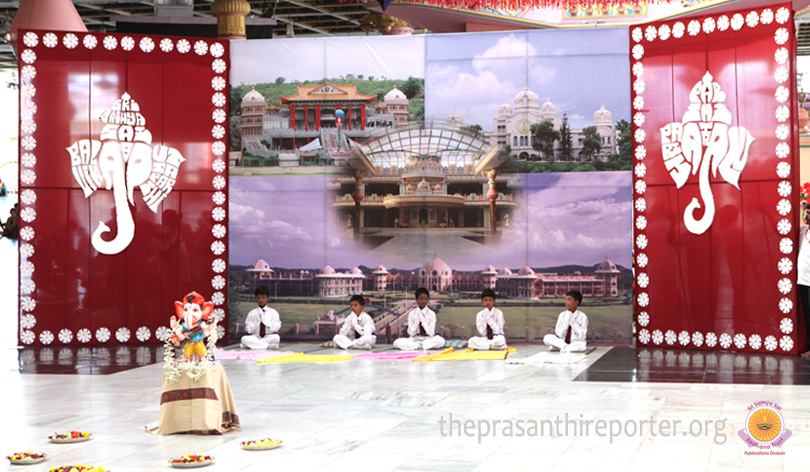
The presentation had beautiful interludes of song and dance sequences, heralding the glory of Sri Sathya Sai Avatar. This is the maiden cultural presentation by the Balvikas of Puttaparthi that had its inception several years ago. Hundred children from in and around the village participated in the presentation.
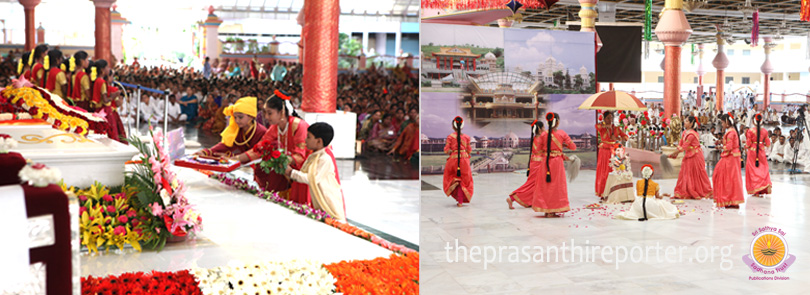
The presentation ended with the children along with elders taking a vow that they would dedicate themselves to the Mission of spreading Bhagawan’s message of Love and Service.
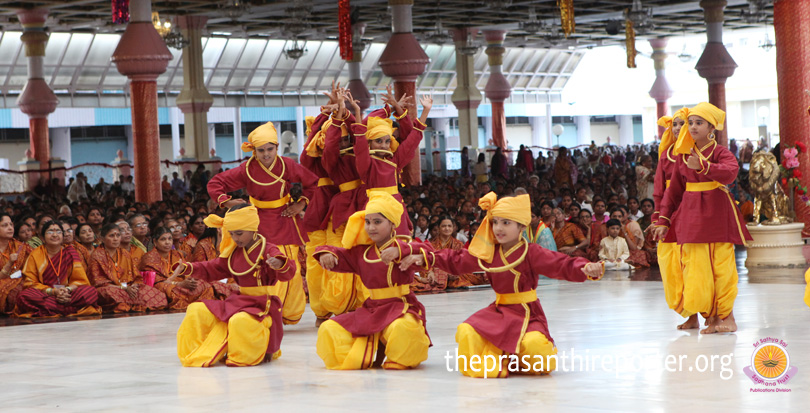
At the end of the presentation all participating children were presented with special gifts. Even as Bhajans continued children formed into disciplined rows posing for photograph session at the Sanctum Sanctorum.

Mangala Arathi was offered at 1815 hrs.
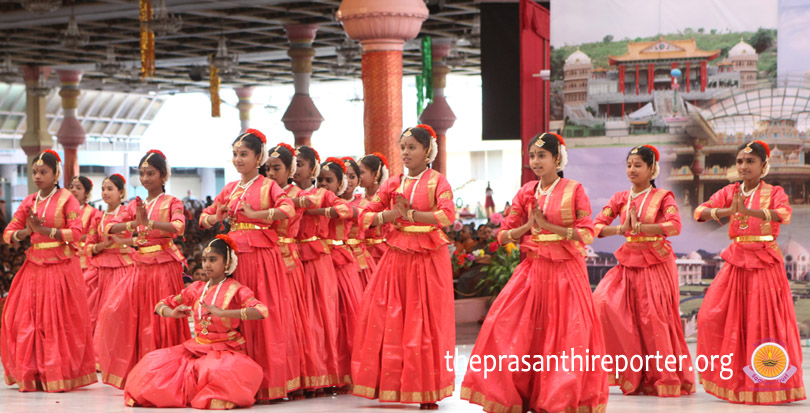
Tomorrow, students from Sri Sathya Sai Vidya Vihar, Moosapet, Hyderabad will be presenting a cultural presentation in the evening in Sai Kulwant Hall.
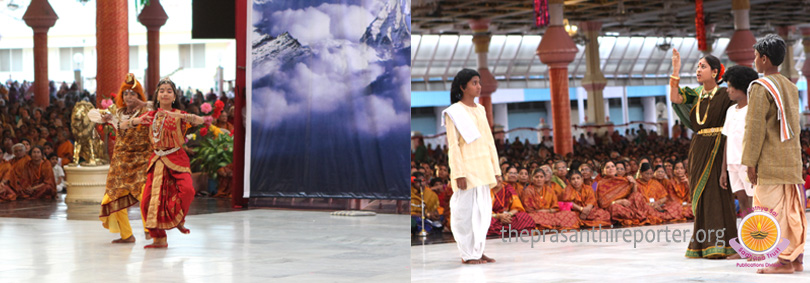
II Samasta Lokah Sukhino Bhavantu II |
|||||||||||
| Musical Offering
and Divine Discourse… Wednesday, September 19th, 2012 |
|||||||||||
|
Celebrating holy Ganesh Chaturthi, students from the Institute offered a string of hymns propitiating Lord Ganesha this morning here in Prasanthi Nilayam. Singing special hymns invoking the Lord, Who is hailed as ‘Prathama Vandana’, the students regaled the audience with devotional music interlaced with instrumental and dance for forty-five minutes. The songs were Ganashtakam beginning with Ekadantam Mahakayam, Mein Ganapathi..., Tatwamariya Tarama, a Carnatic piece, Tujhe Kripaa Taari Ya Jaaga, a Marathi Abhang, Aradhanam Abhivandanam, Apni Dil Kee Pukar Aaye Hain Tujhko Sunaane…The dance was to the tune of Mudaakadaara Modakam, the Ganesha Pancharatnam featuring the purport of the hymn. The instrumental piece was a fusion of Sitar, Violin, Tabla, Flute and Electronic Keyboard playing the bhajan Gowri Nandana Gajanana.
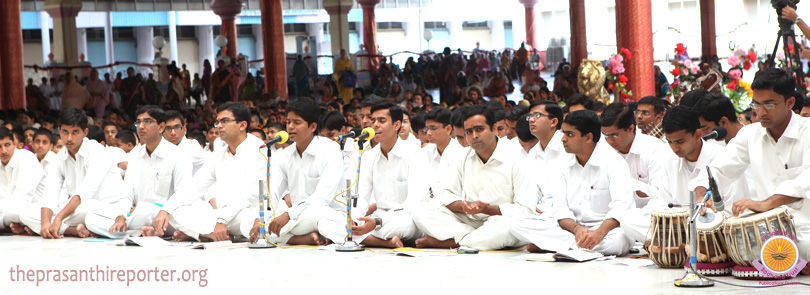
Bhagawan’s Divine Discourse delivered during one of the Vinayaka Chaturthi occasions followed. Calling Vinayaka as the Lord without an Over Lord, Bhagawan discoursed touching upon the inner significance of the festivity. “Our history is replete with sacred inner meanings. But the modern youth do not pay any attention to our history. They waste their time in reading novels and meaningless stories. These kathas (stories) will give only vyathas (sorrow). Divine story alone teaches you the ideal path” said Bhagawan urging the students to take the right path towards Divinity. Speaking on about Brahmacharya, Bhagawan stressed on the need to lead an ideal Brahmacharya life, practising constant contemplation of Brahma.
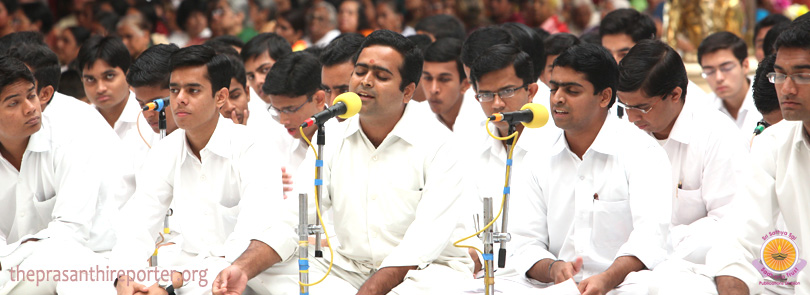
The Divine discourse came to an end with the bhajan “Hari Bhajana Binaa Sukha Shanthi Nahin…”. A string of Ganesha bhajans followed before Mangala Arathi offering at 0950 hrs.
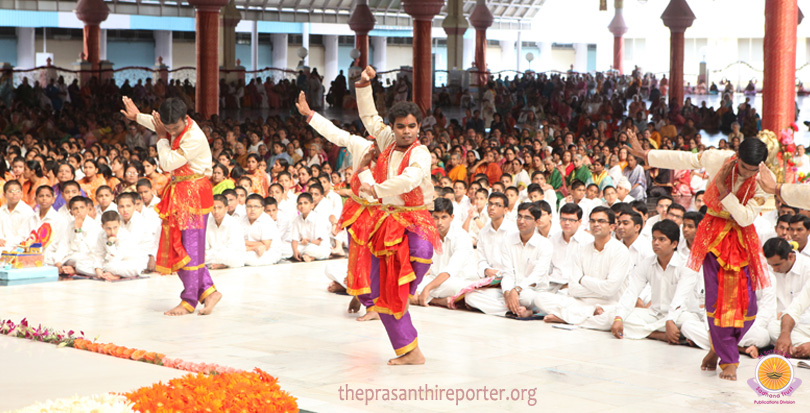
Even as bhajans continued students from the Primary followed by senior students offered festive handmade greetings to Bhagawan at the Sanctum Sanctorum. II Samasta Lokah Sukhino Bhavantu II
|
|||||||||||
| Sri Sathya Sai Vidya Mandir,
Hyderabad Dance Programme…. Thursday, September 20th, 2012 |
|||||||||||
| Colourful children
from Sri Sathya Sai Vidya Mandir, Moosapet, Hyderabad danced
gracefully at the Sanctum Sanctorum offering a Dance Ballet entitled
Sri Sathya Sai Natya Malika this evening here in Prasanthi
Nilayam.
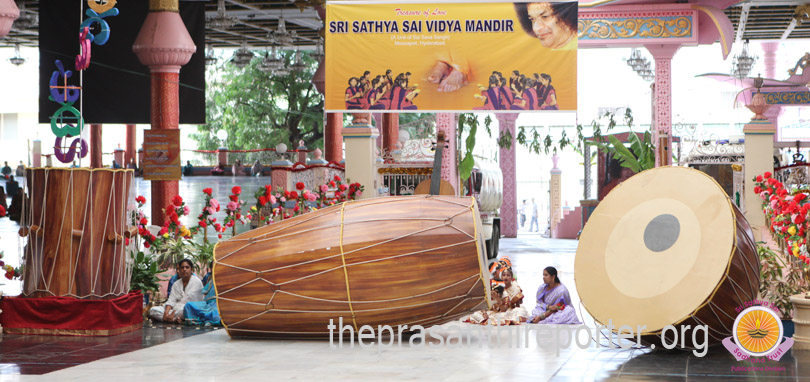
Choreographed uniquely, offering a virtual ritual of Sri Sathya Sai Ashtotharam, the programme was interlaced with thematic dance sequences singing Bhagawan’s Divine glory. The presentation that began with a Ganesha invocation continued with the Ashtotharam that was offered in phases, after every interlude. As the holy chants of Ashtotharam resounded in the vast Sai Kulwant Hall, graceful children danced to a make-shift podium, arranged in front of the Altar, making the offering. Interlacing the Ashtotharam offering, children danced gracefully to the tunes of beautiful songs, regaling the audience for an hour.

Earlier, before the commencement of the programme, children along with organisers offered obeisance at the Sanctum Sanctorum invoking Divine blessings. A brief introduction about the inception of the institution followed after which, Swapna, one of the students from the school spoke in brief reminiscing Bhagawan and His Love. Sai Ashtothara Likhita Japam done 1,17,000 by the devout children of the school was offered at Bhagawan’s Lotus Feet before the commencement of the programme.
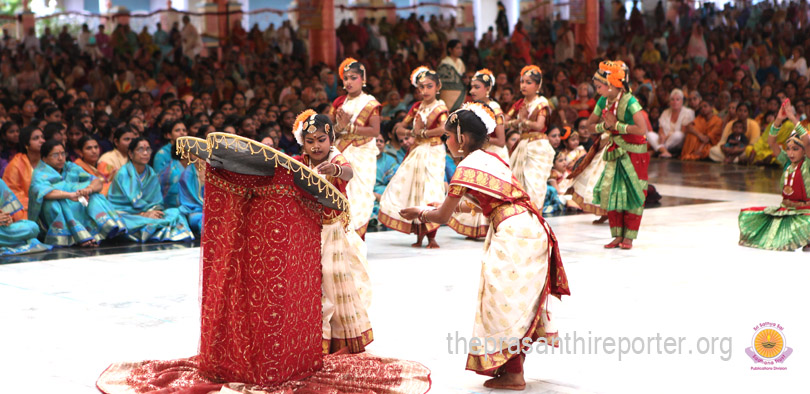
At the end of the programme all the children were presented with special gifts. Even as bhajans continued children posed for photographs. Bhajans ended with Thursday Special “Rama Rama Rama Sita…” The session concluded with Mangala Arathi offering at 1830 hrs.
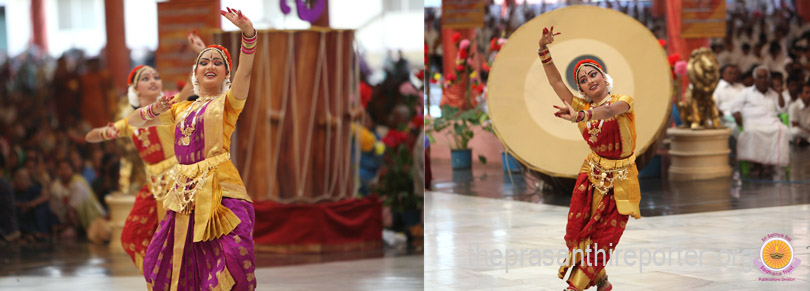
Tomorrow being the third day of the Ganesh Chaturthi festival, scores of Ganesha’s representing various Prasanthi institutions will be brought to the Mandir, in the evening at 1630 hrs., before ceremoniously taking out in procession for immersion. II Samasta Lokah Sukhino Bhavantu II
|
|||||||||||
| Lord Ganesha Immersed with
Festive Gaiety… Friday, September 21st, 2012 |
|||||||||||
| Prasanthi’s three
day Ganesh Chaturthi celebrations, the festival of great spiritual
significance, fun and frolic, culminated this evening marked with
great festive exuberance. Marked by Prasanthi’s special touch of grace and gaiety, scores of Ganeshas in varied hues and contour, flanked by batches of students and staff members, marched into the Sai Kulwant Hall shortly after 1630 hrs. beginning the proceedings for the auspicious evening.
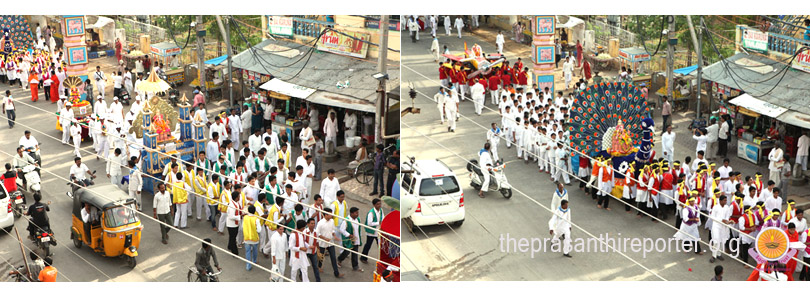
The venue, Sai Kulwant Hall, bore a festive look bustling with great devotional fervour and enthusiasm anticipating the fleet of Ganeshas.
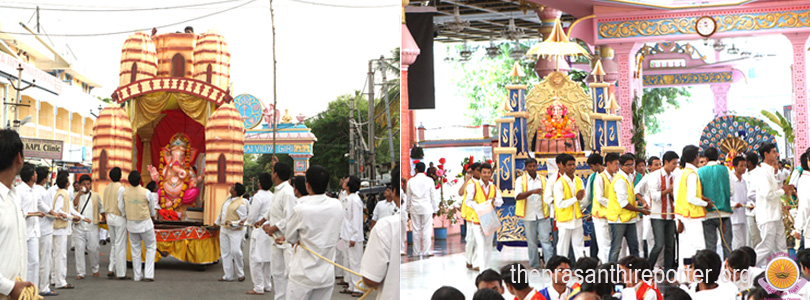
Marching in, exhibiting festive hustle and bustle, Ganeshas, numbering 21, in fanciful shapes and decor, were arrayed in a disciplined order covering the entire stretch of Bhagawan’s darshan pathway.
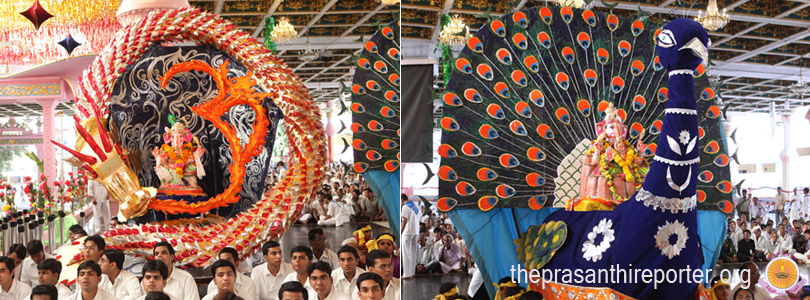
This is the occasion when Prasanthi showcases Ganeshas in varied theme, displaying colourful innovative ideas with the enthusiastic devoted bunch of students putting their best to impress upon The Over Lord of Prasanthi. This year too, like previous years, the procession had all the variety of craftsmanship, depicting spiritual and social themes of relevance.
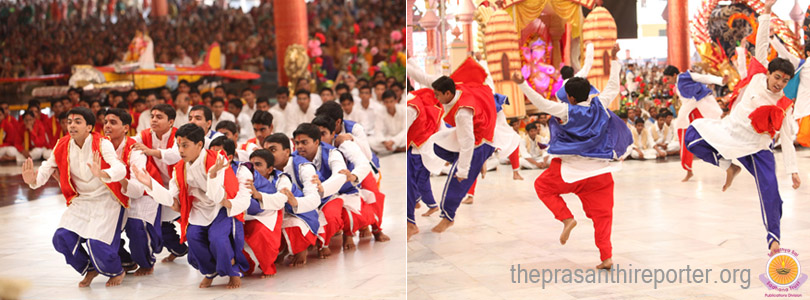
Once the ‘Ganeshas’ were settled in their respective slots, higher secondary students lit up the already exuberant evening with a vibrant musical dance offering, dancing to the tune of a popular song, ‘Sri Ganesha Deva Sri Ganesha Deva…’
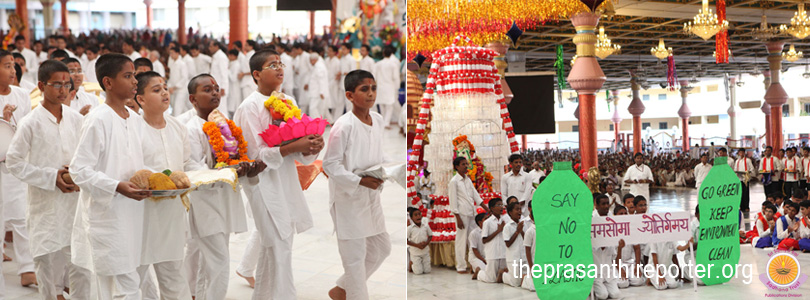
After Mangala Arathi offering to the Ganeshas each group went round the Sanctum Sanctorum. Subsequently each of the Ganesha was brought to the Sanctum Sanctorum, presenting to the Over Lord, before retreating for immersion. The whole exercise was over in an hour.
Bhajans continued for the next 30 minutes and Mangala Arathi was offered at 1800 hrs. II Samasta Lokah Sukhino Bhavantu II
|
|||||||||||
|
Online Pooja &
Aarthi
|
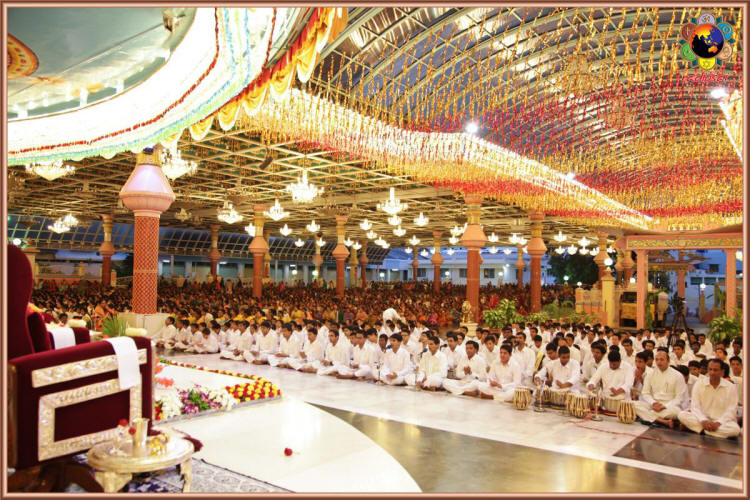
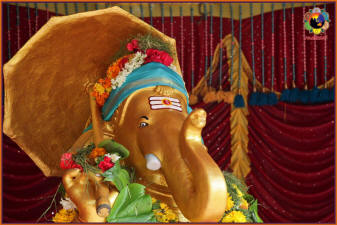
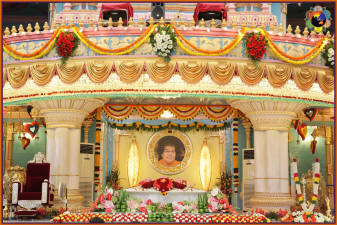
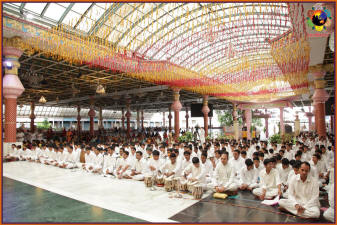
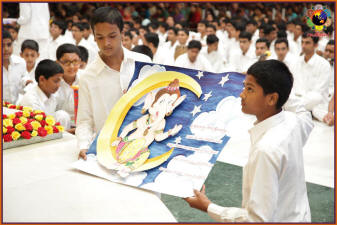
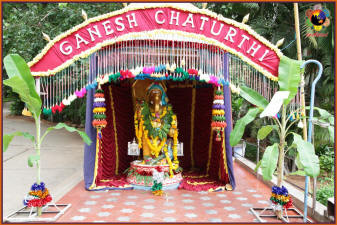
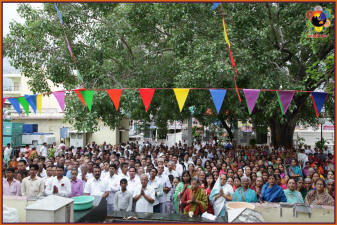
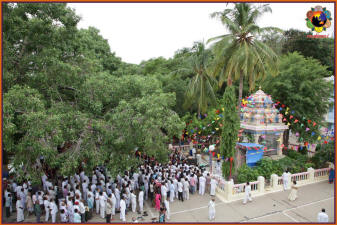
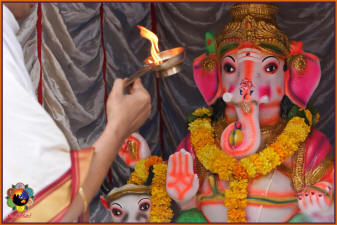
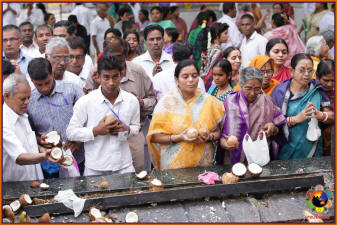
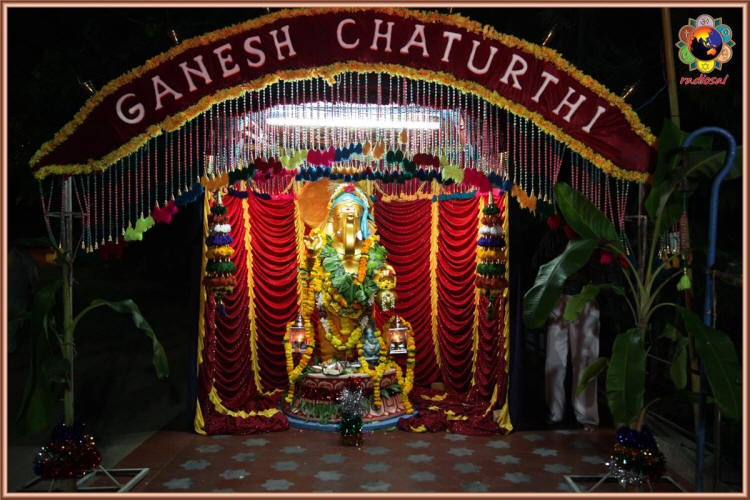
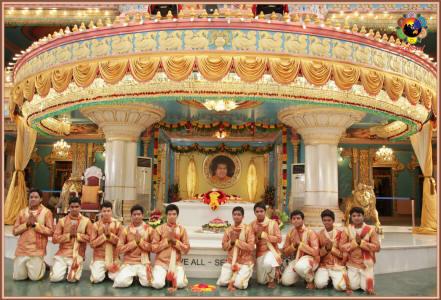
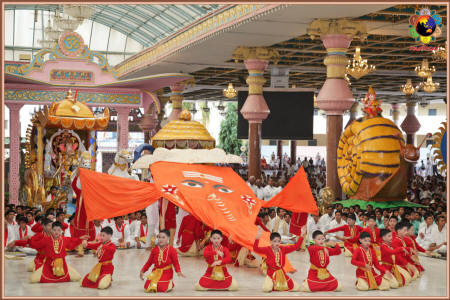
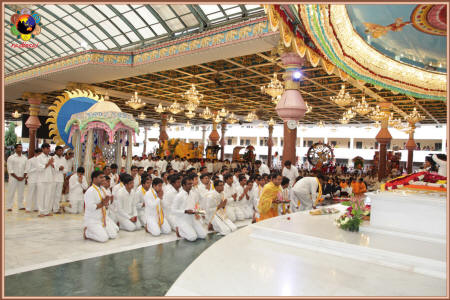
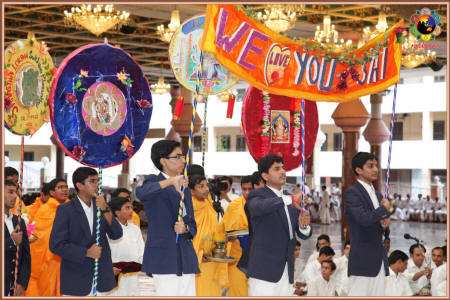
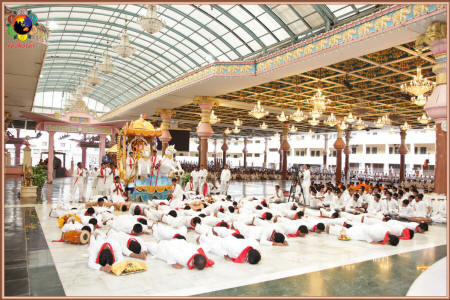
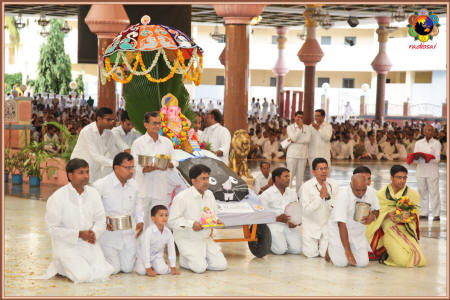
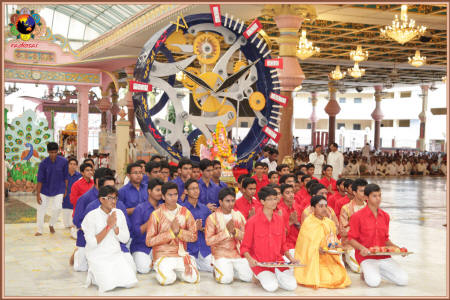
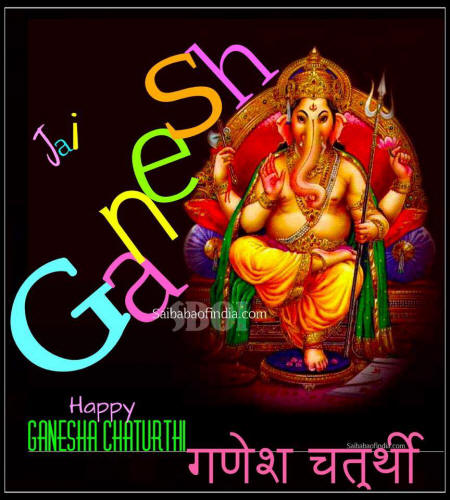
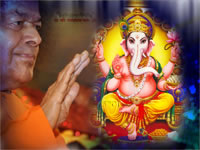
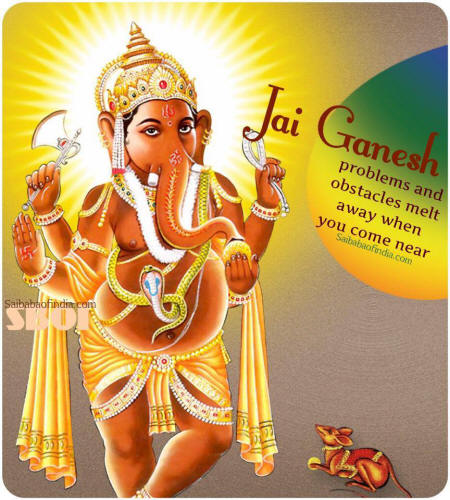
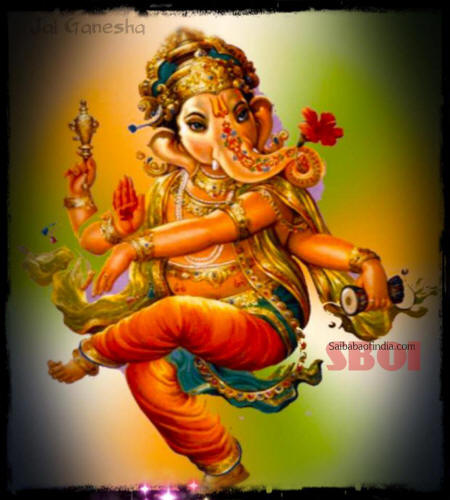
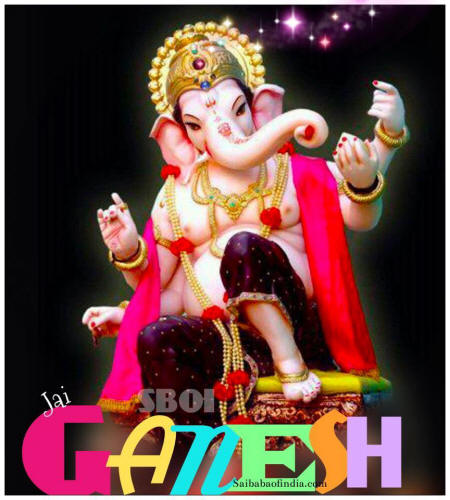
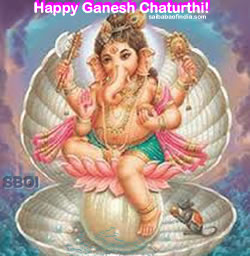
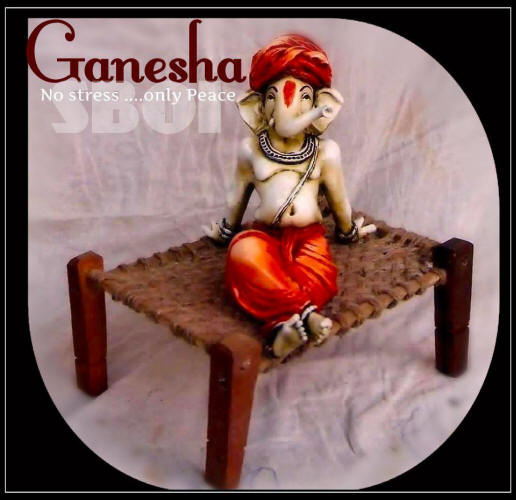
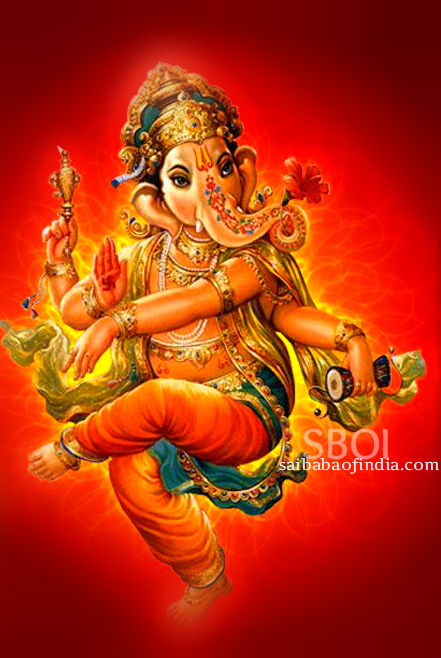 When Prasena did not return, Satrajit
falsely accused Krishna of killing Prasena for the sake of the jewel. Krishna,
in order to remove the stain on His reputation, set out in search of the jewel
and found it in Jambavan’s cave, with his child. Jambavan attacked Krishna
thinking Him to be an intruder Who had come to take away the jewel. They fought
each other for 28 days, when Jambavan, his whole body terribly weakened from the
hammering of Krishna’s fists, finally recognised Him as Rama.
When Prasena did not return, Satrajit
falsely accused Krishna of killing Prasena for the sake of the jewel. Krishna,
in order to remove the stain on His reputation, set out in search of the jewel
and found it in Jambavan’s cave, with his child. Jambavan attacked Krishna
thinking Him to be an intruder Who had come to take away the jewel. They fought
each other for 28 days, when Jambavan, his whole body terribly weakened from the
hammering of Krishna’s fists, finally recognised Him as Rama.